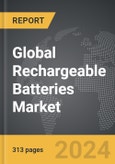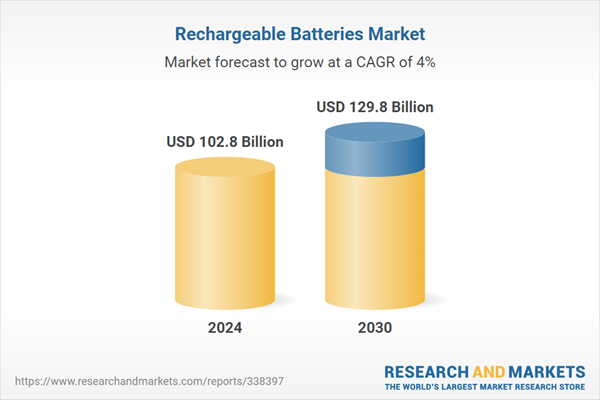Global Rechargeable Batteries Market - Key Trends and Drivers Summarized
How Are Rechargeable Batteries Powering a Portable World?
Rechargeable batteries have become fundamental to modern technology, enabling the growth and portability of countless devices from mobile phones to electric vehicles. Unlike their single-use counterparts, rechargeable batteries can be restored to full charge by applying electrical energy, which reverses the chemical reactions that occur during use. Common types include lithium-ion (Li-ion), nickel-metal hydride (NiMH), and lead-acid batteries, each offering different advantages in terms of energy density, cost, and sustainability. Li-ion batteries, in particular, are favored in most modern applications due to their high energy density and long cycle life, making them ideal for energy-intensive devices such as laptops, smartphones, and electric cars. The shift towards these batteries is driven by a global push for more efficient, durable, and environmentally friendly power sources, reflecting broader trends towards mobility and sustainability.What Technological Innovations Are Shaping the Future of Rechargeable Batteries?
Innovation within the rechargeable battery sector focuses on enhancing efficiency, reducing costs, and improving the environmental footprint of battery production and disposal. Research is heavily directed towards increasing the energy density of Li-ion batteries while reducing the reliance on rare and sometimes controversial materials like cobalt. Breakthroughs in solid-state battery technology promise safer, longer-lasting batteries with faster charging times, potentially revolutionizing everything from consumer electronics to electric vehicles. Meanwhile, advancements in recycling processes aim to recover valuable materials from used batteries, addressing environmental concerns and reducing the need for raw material extraction. Additionally, new formulations and designs are being developed to increase the stability and lifespan of batteries, which are critical for applications in renewable energy storage, where reliability over long periods is crucial.How Does the Global Push for Sustainability Impact Rechargeable Battery Technology?
The global demand for sustainable technology solutions has significantly impacted the development and adoption of rechargeable batteries. As countries and corporations alike commit to reducing carbon footprints, the role of rechargeable batteries becomes increasingly vital, particularly in the energy sector. These batteries are integral to the operation of renewable energy systems, where they store excess power generated by wind or solar sources for later use, thus stabilizing the grid and reducing waste. Furthermore, the electrification of transport - a major component of the sustainability agenda - relies heavily on advances in rechargeable battery technology to improve range and reduce costs in electric vehicles. Environmental regulations and consumer preference for green products also drive improvements in battery technology, emphasizing not only performance but also the recyclability and environmental impact of battery production and disposal.What Drives the Growth in the Rechargeable Battery Market?
The growth in the rechargeable battery market is driven by several factors, including the rapid expansion of the consumer electronics market, increasing adoption of electric vehicles, and a global shift towards energy efficiency and renewable energy sources. Technological advancements that lead to higher energy densities, faster charging times, and longer life spans are key to meeting the performance demands of modern devices and applications. Economic incentives, such as government subsidies for clean energy projects and electric vehicles, also significantly contribute to market growth. Moreover, consumer behavior is increasingly influenced by environmental concerns, leading to greater demand for technologies that support sustainable lifestyles, such as rechargeable batteries. Additionally, as developing economies grow and urbanize, the demand for both portable power solutions and grid energy storage systems rises, further stimulating the development and deployment of advanced batteries. These factors, combined with ongoing investment in research and development from both private and public sectors, ensure continued growth and innovation within the rechargeable battery market.Report Scope
The report analyzes the Rechargeable Batteries market, presented in terms of market value (USD). The analysis covers the key segments and geographic regions outlined below.- Segments: Battery Chemistry (Lead Acid, Lithium-Ion, Other Battery Chemistries); Application (Automotive, Consumer Electronics, Industrial, Other Applications).
- Geographic Regions/Countries: World; United States; Canada; Japan; China; Europe (France; Germany; Italy; United Kingdom; Spain; Russia; and Rest of Europe); Asia-Pacific (Australia; India; South Korea; and Rest of Asia-Pacific); Latin America (Argentina; Brazil; Mexico; and Rest of Latin America); Middle East (Iran; Israel; Saudi Arabia; United Arab Emirates; and Rest of Middle East); and Africa.
Key Insights:
- Market Growth: Understand the significant growth trajectory of the Automotive Application segment, which is expected to reach US$53.3 Billion by 2030 with a CAGR of 4.5%. The Consumer Electronics Application segment is also set to grow at 5% CAGR over the analysis period.
- Regional Analysis: Gain insights into the U.S. market, valued at $27.4 Billion in 2024, and China, forecasted to grow at an impressive 6.9% CAGR to reach $27.4 Billion by 2030. Discover growth trends in other key regions, including Japan, Canada, Germany, and the Asia-Pacific.
Why You Should Buy This Report:
- Detailed Market Analysis: Access a thorough analysis of the Global Rechargeable Batteries Market, covering all major geographic regions and market segments.
- Competitive Insights: Get an overview of the competitive landscape, including the market presence of major players across different geographies.
- Future Trends and Drivers: Understand the key trends and drivers shaping the future of the Global Rechargeable Batteries Market.
- Actionable Insights: Benefit from actionable insights that can help you identify new revenue opportunities and make strategic business decisions.
Key Questions Answered:
- How is the Global Rechargeable Batteries Market expected to evolve by 2030?
- What are the main drivers and restraints affecting the market?
- Which market segments will grow the most over the forecast period?
- How will market shares for different regions and segments change by 2030?
- Who are the leading players in the market, and what are their prospects?
Report Features:
- Comprehensive Market Data: Independent analysis of annual sales and market forecasts in US$ Million from 2024 to 2030.
- In-Depth Regional Analysis: Detailed insights into key markets, including the U.S., China, Japan, Canada, Europe, Asia-Pacific, Latin America, Middle East, and Africa.
- Company Profiles: Coverage of players such as Battery Technology Inc., Beckett Energy Systems, BYD Company Ltd., Duracell Inc., EaglePicher Technologies, LLC and more.
- Complimentary Updates: Receive free report updates for one year to keep you informed of the latest market developments.
Some of the 286 companies featured in this Rechargeable Batteries market report include:
- Battery Technology Inc.
- Beckett Energy Systems
- BYD Company Ltd.
- Duracell Inc.
- EaglePicher Technologies, LLC
- Energizer Holdings, Inc.
- E-One Moli Energy Corp.
- Eveready Industries India Ltd.
- FDK Corp.
- GS Yuasa Corp.
- Highpower International Inc.
- Jiangmen TWD Technology Co., Ltd.
- Johnson Controls International Plc
- LG Chem
- Maxell Holdings, Ltd.
- Panasonic Corp.
- Saft Groupe S.A.
- Samsung SDI Co. Ltd.
- Spectrum Brands, Inc.
- Tohoku Murata Manufacturing Co., Ltd.
- Ultralife Corp.
- VARTA Consumer Batteries GmbH & Co. KGaA
This edition integrates the latest global trade and economic shifts into comprehensive market analysis. Key updates include:
- Tariff and Trade Impact: Insights into global tariff negotiations across 180+ countries, with analysis of supply chain turbulence, sourcing disruptions, and geographic realignment. Special focus on 2025 as a pivotal year for trade tensions, including updated perspectives on the Trump-era tariffs.
- Adjusted Forecasts and Analytics: Revised global and regional market forecasts through 2030, incorporating tariff effects, economic uncertainty, and structural changes in globalization. Includes historical analysis from 2015 to 2023.
- Strategic Market Dynamics: Evaluation of revised market prospects, regional outlooks, and key economic indicators such as population and urbanization trends.
- Innovation & Technology Trends: Latest developments in product and process innovation, emerging technologies, and key industry drivers shaping the competitive landscape.
- Competitive Intelligence: Updated global market share estimates for 2025, competitive positioning of major players (Strong/Active/Niche/Trivial), and refined focus on leading global brands and core players.
- Expert Insight & Commentary: Strategic analysis from economists, trade experts, and domain specialists to contextualize market shifts and identify emerging opportunities.
Table of Contents
Companies Mentioned (Partial List)
A selection of companies mentioned in this report includes, but is not limited to:
- Battery Technology Inc.
- Beckett Energy Systems
- BYD Company Ltd.
- Duracell Inc.
- EaglePicher Technologies, LLC
- Energizer Holdings, Inc.
- E-One Moli Energy Corp.
- Eveready Industries India Ltd.
- FDK Corp.
- GS Yuasa Corp.
- Highpower International Inc.
- Jiangmen TWD Technology Co., Ltd.
- Johnson Controls International Plc
- LG Chem
- Maxell Holdings, Ltd.
- Panasonic Corp.
- Saft Groupe S.A.
- Samsung SDI Co. Ltd.
- Spectrum Brands, Inc.
- Tohoku Murata Manufacturing Co., Ltd.
- Ultralife Corp.
- VARTA Consumer Batteries GmbH & Co. KGaA
Table Information
| Report Attribute | Details |
|---|---|
| No. of Pages | 313 |
| Published | December 2025 |
| Forecast Period | 2024 - 2030 |
| Estimated Market Value ( USD | $ 102.8 Billion |
| Forecasted Market Value ( USD | $ 129.8 Billion |
| Compound Annual Growth Rate | 4.0% |
| Regions Covered | Global |









